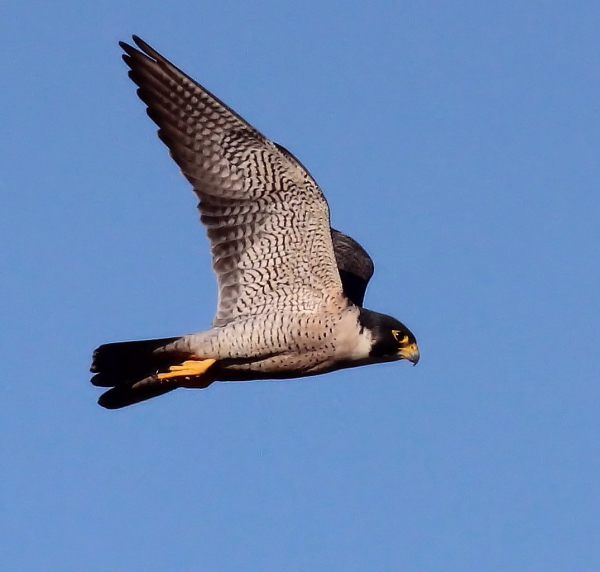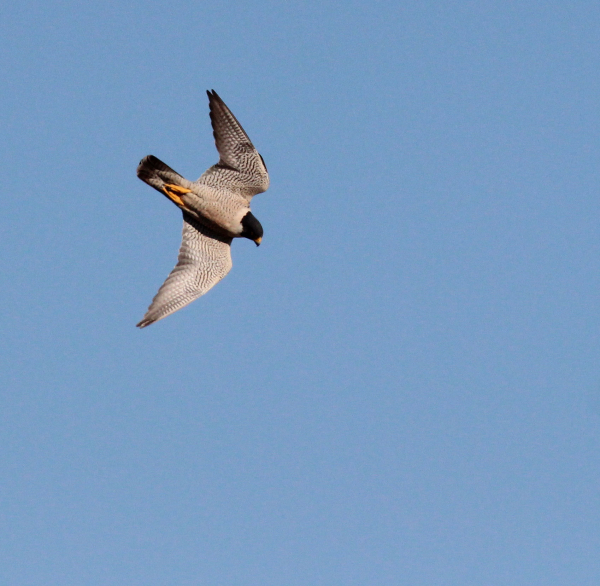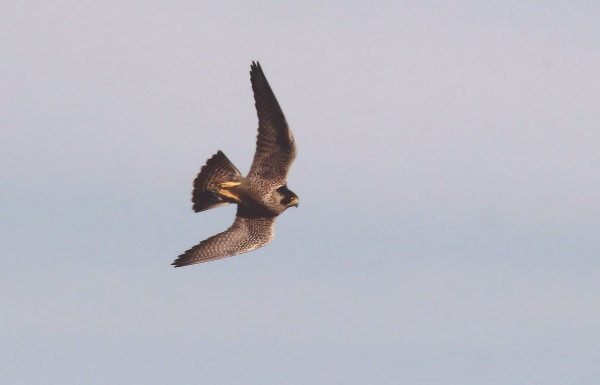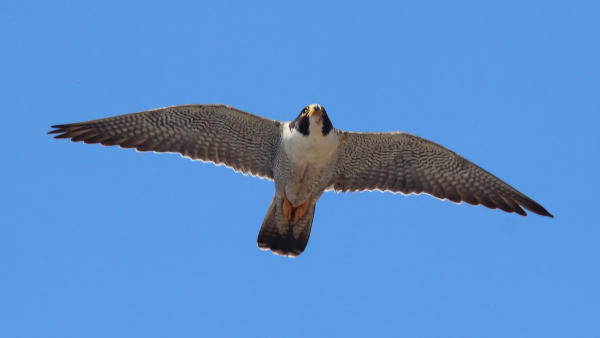 The sleek aerodynamic form of Peregrine Falcons in flight, especially diving flight, is impressive. The fact that Peregrines can be found on six continents and islands in the Antarctic realm, from the Arctic to the tropics, from mountain peaks to the sea, is indicative of their adaptive successes as a bird species.    |
International travel is one of my passions in life, and studying the wildlife of the world is a big part of that passion. Although I enjoy touring European art museums, Egyptian pyramids, the Taj Mahal and the Great Wall too, I am always attracted to the wildlands, often beyond the last road, where I can observe and photograph interesting wildlife. During my most recent trip to Australia, I sought out such a wild area in the heart of Kuringai Chase National Park north of Sydney. With the wild calls of Sulphur-crested Cockatoos echoing through the expansive eucalyptus forest, I stepped out on a rock precipice to survey the valley below for birds.
Suddenly, a falcon stooped swiftly from left to right across the panoramic valley. I was elated and hoped to identify the speeding raptor as one of the Australian endemics, perhaps a Gray Falcon, a Brown Falcon, or a Black Falcon. I must admit I was a little disappointed when it became clear the sleek raptor was a Peregrine Falcon, and not a new species; but I reveled at its flight above the coastal forest as it soared overhead in ever-larger circles for a long period. As I followed the falcon with my binoculars, I realized the true significance of this observation: Australia was the sixth continent where I have observed this cosmopolitan species, the Peregrine Falcon.
As I prepared my notes about this sighting, I turned back to a page written a continent away that explained my being in some small way: “What fuels my worldly travels – the peregrinations, the wanderlust? Wild animals in wild lands, and some inner psychological fuel to see, to experience, to photograph.” This prose inspired me to share a short story with you about a representative Peregrine Falcon sighting on each of the continents:
During my first trip to Asia, as I walked through the maze of ponds at Keoladeo Ghana National Park in central India, I spied a Peregrine perched quietly on a branch in a tall tree rooted on the edge of a wetland where I also observed Painted Storks, Purple Herons, White-breasted Kingfishers, Pallas's Fish Eagles, endangered Siberian Cranes, and the tallest flying birds in the world, Indian Sarus Cranes.
In the verdant Amazon rainforest on the eastern edge of Peru, I reveled at the chance to view an adult Peregrine Falcon in South America along a steep Andes slope in the cloud forest altitudes of Manu National Park. I traveled there to experience the mating activities of Andean Cocks-of-the-Rock at an historic lek where as many as a dozen brilliant red and black males assembled in the treetops to perform impressive displays with piercing jungle calls. There, the Peregrine shared the valley filled with rain-fed waterfalls and remarkable mixed-species flocks of tropical birds that filtered up and down the mountain slopes like the mist-laden clouds. All this among a sensational diversity of other birds numbering more than 1,000 species in Manu alone!
Perhaps the most southern limit of the Peregrine Falcon’s range is Seal Island, on the northern edge of the Antarctic realm in the Falkland Islands. There, while photographing such remarkable species as Gentoo and Rock-hopper Penguins, Giant Petrels, Brown Skuas, and Southern Elephant Seals, I was excited to see a sleek Peregrine Falcon hunting across the uplands near the south end of the tree-less isle. (Although it’s not Antarctica proper, close enough, the Falklands are within the Antarctic realm).
Of course, I’ve enjoyed many, many Peregrine sightings in North America – while living at the beach in San Diego, I was thrilled to see Peregrines out my front window, and from my back doorstep. But perhaps my most memorable observation featured a Peregrine Falcon that pursued a small flock of Yellow-headed Parrots above the tropical forest covering the mountain spine of a Mexican island, Isla Maria Magdalena of the Tres Marias Islands. The falcon chased the parrots in earnest, first separating a single Amazon parrot, then repeatedly stooping in the world’s fastest diving flight toward the fast-flying parrot. The two birds were sometimes only a few feet apart as the falcon pressed forward aggressively, with the parrot reacting by twisting and turning as it frantically beat its wings to elude the predator. It was a thrilling chase that made my heart beat faster for almost a minute, until the Peregrine gave up the chase and spiraled off above the tropical isle.
The only continent where I haven’t seen a Peregrine Falcon (to date) is Europe. I have visited Europe five times, but no falcons. To be fair, Europe hasn’t been much of a wildlife destination for me and I’ve really only visited two European countries. It’s a place to enjoy a variety of cultures and languages in a relatively small area; where art, architecture, history, culinary tastes, and a wealth of other subjects can be appreciated in many ways. I have seen many interesting birds in Europe, but so far, no Peregrine Falcons.
After writing this, I revisited my earlier quote, which I wrote after reaching my seventh continent – Antarctica – and added a small update: “What fuels my worldly travels – the peregrinations, the wanderlust? Wild animals in wild lands, and some inner psycho-logical fuel to see, to experience, to photograph – and to share, to inform, to inspire.”
Article and photos by Paul Konrad
Share your birding experiences and photos at editorstbw2@gmail.com
